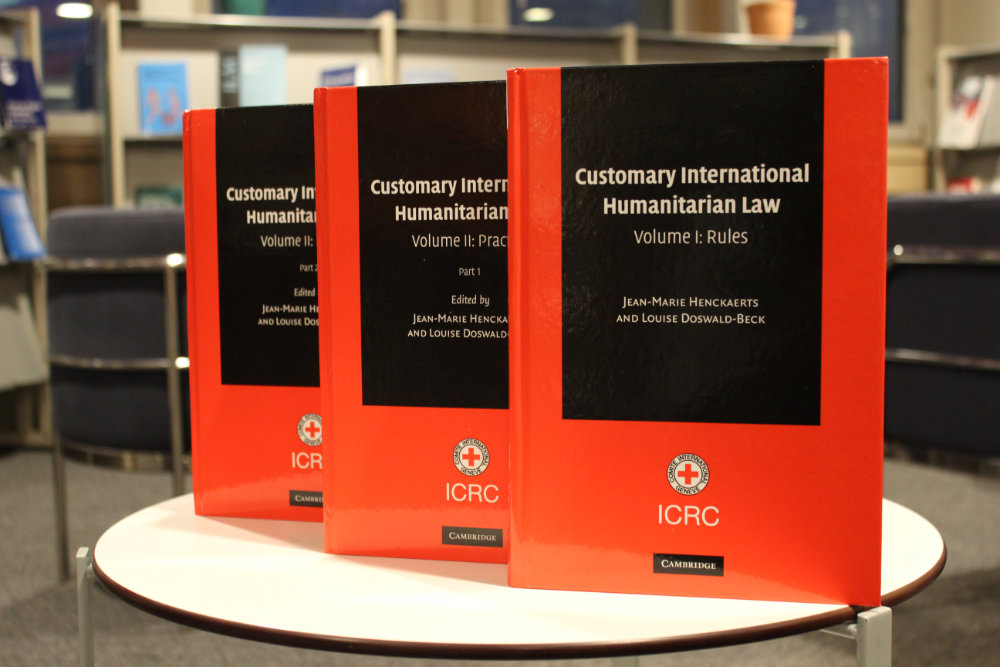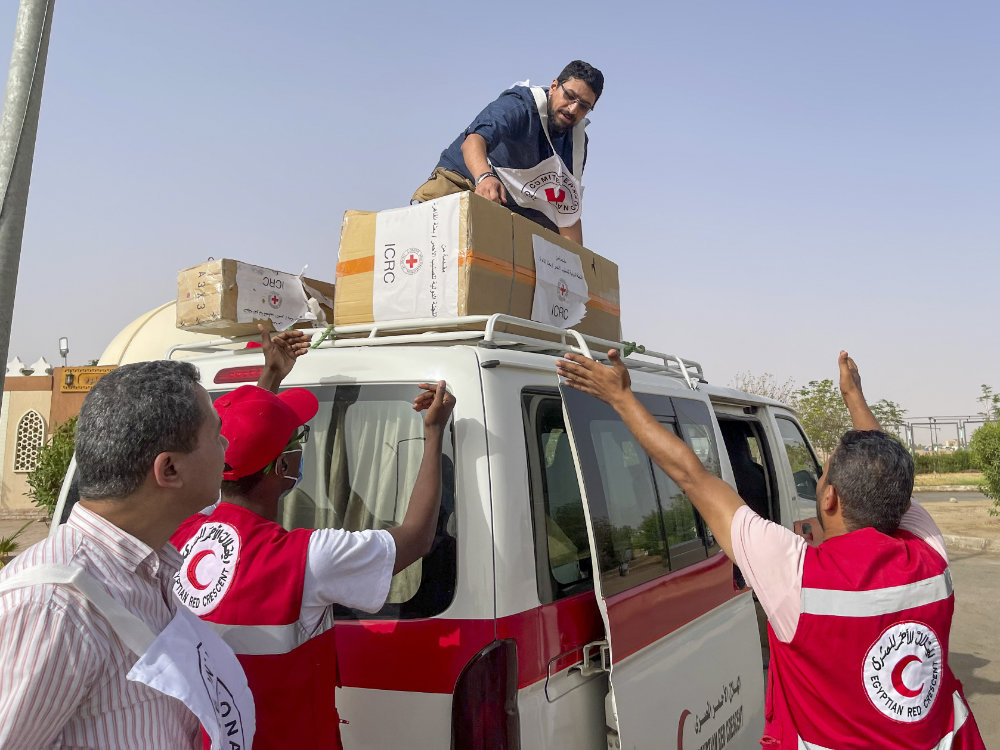As states increasingly focus on strengthening their defense capabilities, discussions on military preparedness are gaining prominence, particularly in relation to large-scale conflicts. Such conflicts, involving major powers, advanced weaponry, and extensive resources, would unfold with considerable intensity, scale, and tempo. The humanitarian consequences would be far-reaching and severe, potentially causing mass casualties, mass displacement, and the disruption of essential services. The Geneva Conventions, adopted in the aftermath of two world wars, were designed precisely to help mitigate the suffering in armed conflict. Yet ratification alone is not enough: for these rules to be upheld in practice, extensive legal and operational preparations must begin in times of peace.
This introductory post sets the stage for a new series examining the steps needed to ensure compliance with international humanitarian law (IHL) in large-scale conflicts. Isabelle Gallino, ICRC Prevention Adviser, and Sylvain Vité, ICRC Senior Legal Adviser, argue that states must do more than recognize their legal obligations. Applicable rules must be understood, internalized, and backed by legal and practical measures today if they are to be effective once an armed conflict erupts. Ultimately, failure to prepare can undermine even the best-intentioned efforts to comply with IHL.
When contemplating the potential consequences of a large-scale conflict – the destruction, suffering and deep societal scars – it is natural to hope that this scenario will remain just that: a hypothetical that never materializes, the concern of overly cautious observers. Yet history has shown us that humanity does not always act with wisdom and that, once the machinery of war is set in motion, appeals to reason are drowned out in the cacophony of violence. It is in times of peace, therefore, that states must agree on the rules that will govern their conduct in war.
The Geneva Conventions, which set out the fundamental rules of international humanitarian law (IHL), were born in 1949 from the world’s resolve – in the aftermath of two devastating world wars – to establish clear rules during peacetime that would mitigate suffering in future conflicts, preserving a measure of humanity even in the bleakest moments.
Today, the very reasons that led to the adoption of these conventions seem more relevant than ever. Armed conflicts continue in their most brutal forms across different parts of the world, causing extensive casualties and destruction. Meanwhile, peaceful states are increasingly focused on strengthening their defense capabilities in response to perceived existential threats or challenges to their sovereignty. Preparation for potential conflicts involving so-called “Great Powers” or “Peers” is particularly concerning. The availability of weapons of mass destruction, new technologies, and vast resources would likely escalate the intensity and scale of a confrontation, with tragic humanitarian consequences. In this context, the importance of the Geneva Conventions – and international humanitarian law more broadly – cannot be overstated.
Recent conflicts have shown that ratifying conventions minimizing the destructive impact of war is an essential first step, but not enough. Today, perhaps more at any time since their drafting, their validity and importance must be reaffirmed by the community of states. A renewed sense of ownership and commitment is crucial as belligerent narratives and military build-ups intensify.
This series illustrates the measures that need to be taken ahead of time to ensure compliance with IHL and examines the challenges observed and anticipated in large-scale conflicts. In doing so, it underscores the raison d’être of the Geneva Conventions and their carefully designed institutional architecture. Ultimately, while these rules set the absolute minimum for conduct in a large-scale conflict, every effort must be made to prevent such devastation – as true protection lies in avoiding war itself.
IHL in large-scale conflicts
All armed conflicts bring destruction and suffering, regardless of their size or nature. In recent years, however, states have increasingly focused on preparing for what are often called “large-scale military operations” (LSMOs) or “large-scale combat operations” (LSCOs), reflecting a broader shift towards readiness for conflicts of a higher intensity and scale. These conflicts typically involve major powers wielding highly sophisticated weaponry, capable of conducting intensive military operations over vast geographical areas. They feature significant troop deployments that could involve multiple actors beyond regular state armed forces, as well as coalition warfare. Fought across various operational domains – land, air, sea, space and cyber – they result in widespread humanitarian consequences, including casualties, destruction, displacement, detention, and severe disruptions to access to essential services, such as water, food, healthcare, and electricity.
“Large-scale conflict” is not a term found in IHL. Instead, the Geneva Conventions distinguish between two types of conflicts: international armed conflicts (IACs), occurring between two or more states; and non-international armed conflicts (NIACs), involving a state and non-state armed group(s) or a conflict between such groups. IHL applies to both, though the legal framework for IACs is more detailed. A large-scale conflict may, therefore, fall within either of these categories, or a combination of both, depending on the parties involved and the circumstances.
While a conflict’s large-scale nature does not affect the applicability of IHL, it is still a critical issue to address. First, because of its vast humanitarian consequences: large-scale conflicts, by their very nature, result in a great number of deaths and injuries, a significant number of prisoners, mass displacement, and widespread destruction of infrastructure and the natural environment. Their intensity, scale and tempo can have catastrophic long-term consequences, impacting generations to come. Second, the high level of technological sophistication and destructive capabilities expected in these scenarios would further exacerbate the humanitarian impact. Third, certain narratives surrounding large-scale conflicts – particularly claims of “exceptionalism” – pose a real danger, as they suggest that the scale of a conflict could justify an expanded interpretation of permissible actions, undermining IHL’s life-saving protections.
Peacetime preparedness for compliance with IHL
Having ratified the 1949 Geneva Conventions and other key treaties, and through customary law, states are bound to take both legal and practical measures to ensure compliance with their IHL obligations. Some of these measures must be enacted in peacetime to ensure that government authorities, military personnel, and the broader population are familiar with the rules of IHL and that the necessary legal frameworks, administrative structures and processes are in place.
States adopted the Conventions with the understanding that, once an armed conflict erupts, implementing these measures amidst wartime turmoil becomes far more challenging. The obligation to act in peacetime stems from Common Article 1 of the Geneva Conventions, which requires High Contracting Parties to “respect and ensure respect” for IHL. As the ICRC clarifies (ICRC Third Geneva Convention Commentary, para. 178), “the High Contracting Parties must – starting in peacetime – take all measures necessary to ensure respect for the Conventions. Respecting the Conventions in case of an armed conflict regularly presupposes that preparations have been made in advance”.
These preparedness obligations apply to both IACs and NIACs (ICRC Third Geneva Convention Commentary, para. 158). Ensuring compliance with IHL requires States to take action in three key areas: first, disseminating IHL – not only within the armed forces but also to the broader populations – so that both soldiers and civilians understand these rules.[1] Second, adopting the necessary legal and administrative framework, including translating and integrating IHL into national laws, regulations and military doctrine, and identifying or establishing authorities and processes needed to ensure full respect for IHL.[2] Third, implementing practical measures such as building relevant infrastructure, allocating sufficient resources and training personnel. Peacetime preparation will strengthen a state’s ability to uphold its obligations under IHL, even amid the operational challenges and demands of armed conflict.
Building a culture of compliance in large-scale conflict
Anticipating the humanitarian challenges of large-scale conflicts requires recognizing the obstacles posed by their intensity, scale, and tempo, as well as the existential pressures that states may perceive in such scenarios. The interconnectedness of modern societies – through global supply chains, financial networks, telecommunications, and shared digital infrastructure – means that an attack on one object can trigger ripple effects, disrupting essential services for civilians and extending consequences well beyond the immediate conflict zone. Additionally, advanced technologies, including cyber and autonomous weapons systems, introduce new challenges to safeguarding civilian infrastructure and, more generally, ensuring compliance with IHL. States must be prepared to navigate the complex responsibilities and challenges that would come with such conflicts.
In such scenarios, States bear the primary responsibility for meeting the essential needs of civilians under their control and must plan accordingly for the humanitarian demands of large-scale conflicts. This includes establishing systems and procedures to provide essential resources – including food, water and medical care – in areas severely affected by the conflict. While humanitarian actors play a key role in crisis response, the scale of such conflicts will likely exceed their capacity to respond, making it essential for states to take on substantial responsibilities in delivering essential services to meet the basic needs of the population.
The scale of medical and forensic needs must also be anticipated. Before a large-scale conflict erupts, states must have legal, institutional, and logistical frameworks in place to search for, collect and evacuate the wounded, sick, shipwrecked, and dead; to manage the remains of those who perish during hostilities; and to prevent people from going missing. States must also be prepared to provide the necessary medical care for those affected, ensuring that adequate medical infrastructure, personnel, and supplies are in place.
Mass displacement is another likely consequence of large-scale conflict. States must be prepared to accommodate displaced populations safely and uphold their rights, especially vulnerable groups, such as children, the elderly, and persons with disabilities.
As for the fighting itself, large-scale conflicts would likely involve highly advanced means and methods of warfare, multi-domain targeting, coupled with rapid decision-making on targeting. Yet this must not dissuade states from upholding their commitment to IHL rules and principles. Preparing for compliance with IHL requires anticipating these challenges, incorporating lessons from previous large-scale combat operations, and ensuring that military training rigorously reinforces capabilities to respect the principles of distinction, proportionality, and precaution – even under extreme conditions.
State-specific preparedness in international armed conflicts
As mentioned, IACs impose specific legal obligations and practical constraints on states, requiring advance preparation. Detention-related operations are a key example. The Geneva Conventions establish detailed requirements for the internment of prisoners of war and other persons deprived of liberty. This framework is aimed to ensure that these persons enjoy humane treatment and necessitates that appropriate institutional mechanisms, infrastructures, training, and processes are in place. When anticipating a potential large-scale IAC, states must estimate the potential number of detainees, allocate the necessary personnel, resources, and logistics that would be needed to manage the operation in compliance with IHL, and identify suitable detention facilities that meet IHL standards.[3]
Occupation in IAC also demands careful planning. Under the Hague Regulations of 1907 and the Fourth Geneva Convention of 1949, an occupying power has extensive responsibilities towards the civilian population in occupied territories. This includes the restoration and maintenance of public order and safety and, in general terms, the administration of the occupied territory for the benefit of the population.[4] Anticipating these legal obligations requires proactive planning, as the demands of the law of occupation can place significant strain on military resources and capabilities.
Large-scale military operations at sea present additional challenges. State must develop capacity to search for, collect, evacuate potentially vast numbers of wounded, sick and shipwrecked individuals, ensuring they receive proper medical care.[5] Capacity building also applies to states’ obligations to search for, collect and evacuate the dead without adverse distinction,[6] a task complicated by vast maritime areas. Handling combatants captured at sea also require proper measures to ensure that these persons will benefit from all the legal protections they are entitled to under IHL while detained at sea, and that they will be transferred to land as quickly as possible.[7]
Conclusion
Hopefully, the world will never see another large-scale conflict, and we should all do everything in our power to never let that happen. At the same time, state parties to the Geneva Conventions have a duty to ensure that frameworks and mechanisms are in place to protect human integrity and dignity should the unthinkable occur. The Geneva Conventions were born from humanity’s darkest moments – our responsibility today is to ensure that the lessons learned are never forgotten, and that these minimum standards are upheld now and in the future.
Authors’ note: The authors would like to express their gratitude to Abby Zeith, Lindsey Cameron, Nishat Nishat, and Thomas de Saint Maurice for contributing to the ideas developed in this post.
References
[1] First Geneva Convention, Art. 47; Second Geneva Convention, Art. 48; Third Geneva Convention, Art. 127; Fourth Geneva Convention, Art. 144; Additional Protocol I, Arts. 6, 82, 83; Additional Protocol II, Art. 19; Customary IHL Study, Rule 143.
[2] First Geneva Convention, Arts. 48-49; Second Geneva Convention, Arts. 49-50; Third Geneva Convention, Arts. 128-129; Fourth Geneva Convention, Arts. 145-146; Additional Protocol I, Arts. 84, 85; Customary IHL Study, Rule 139.
[3] See the next contribution to this series, on large-scale detention operations in international armed conflicts.
[4] See Art. 43 of the Regulations concerning the laws and customs of war on land of 1907; and Art. 64 of the Fourth Geneva Convention.
[5] Second Geneva Convention, Art. 18 and Additional Protocol I, Art. 10.
[6] Second Geneva Convention, Art. 18.
[7] Third Geneva Convention, Art. 22.
See also:
- Cordula Droege, Championing IHL compliance in contemporary armed conflict: the 2024 ICRC Challenges Report, October 9, 2024
- Kelisiana Thynne, Thomas de Saint Maurice, IHL in the aftermath of battles and conflicts: what do we want to achieve?, July 14, 2022
- Sahr Muhammedally, Preparedness in urban operations: a commander’s planning checklist to protect civilians, May 11, 2021






